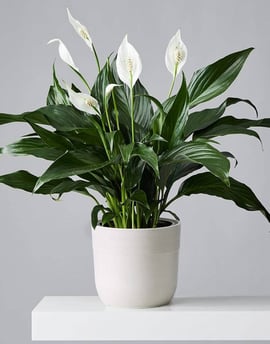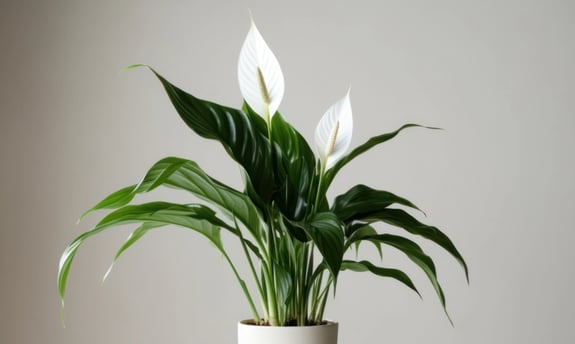Get 20% off on your first order!
How to Care for a Peace Lily: A Friendly Guide for Beginners
Peace lilies are beautiful, low-maintenance plants perfect for beginners. They thrive in bright, indirect light and need consistent moisture, but are forgiving and resilient if you miss a watering.
Omer Hazem
5/8/20245 min read


Hey there, plant-loving friend! 🌿 Are you thinking about adding a peace lily to your home or already have one sitting pretty on your shelf? Either way, you’ve made a wonderful choice! Peace lilies (**Spathiphyllum**) are not only stunning with their glossy green leaves and elegant white flowers, but they’re also relatively easy to care for, making them perfect for beginners.
So, grab your favorite drink, get comfy, and let’s walk through how to take care of your peace lily so it thrives and brings you joy for years to come.
1. Choosing the Right Spot for Your Peace Lily
First things first: where to place your peace lily. These beauties love bright, indirect light. They don’t need to be right by a window, but they do enjoy being in a room with natural light. If you place them in too much direct sunlight, their leaves can get scorched, so be careful not to put them in the sunniest spot in the house. A little shade is perfectly fine.
If you don’t have a ton of natural light, no worries! Peace lilies can tolerate low light environments, but they may not flower as much. If you're okay with just the lush green leaves, they’ll still look beautiful!
Tip: If the leaves are turning yellow, it might be getting too much light. If the plant looks droopy and dark, it might want a bit more light. You’ll find a sweet spot with a little experimenting!
2. Watering Your Peace Lily: Keep It Moist but Not Soggy
Peace lilies are tropical plants, so they like their soil to be consistently moist, but not waterlogged. Overwatering is a common mistake, but don’t worry! We’ll help you get it just right.
Here’s a rule of thumb: Water your peace lily when the top inch of the soil feels dry. You can check this by sticking your finger into the soil. If it feels dry to the touch, it’s time to water.
When you water, give it a thorough soak, letting the water drain out of the bottom of the pot. Just be sure to empty the saucer underneath afterward—peace lilies don’t like their roots sitting in water.
Tip: Peace lilies are great at communicating when they’re thirsty! Their leaves will start to droop when they need a drink. Once you water them, they’ll perk back up within a few hours. If your plant’s drooping often, you may need to adjust your watering routine.
3. Humidity and Temperature: Keeping It Cozy
Peace lilies thrive in humid environments, so if you live in a dry area, your plant might appreciate a little extra moisture. Don’t worry, you don’t need to create a rainforest in your home! A few simple tricks can help:
- Mist your peace lily once in a while to mimic humidity.
- Group your plants together—plants naturally increase humidity around them.
- Place the plant on a tray with water and pebbles. As the water evaporates, it adds a bit of humidity.
As for temperature, peace lilies love the same cozy temperatures we do: around 65°F to 80°F (18°C to 27°C). Keep them away from cold drafts, heaters, and air conditioners, as they can be a bit sensitive to extreme temperature changes.
4. Fertilizing Your Peace Lily: A Little Boost Every Now and Then
Peace lilies don’t need much fertilizing, but they do appreciate a little boost every now and then. You can feed your peace lily with a balanced, water-soluble fertilizer about once a month during the spring and summer months (their growing season). Just be sure to dilute the fertilizer to half the recommended strength to avoid overwhelming the plant.
In the fall and winter, peace lilies usually slow down their growth, so you can skip the fertilizer during those months.
Tip: If you notice the leaves turning brown or yellow, it could be a sign of over-fertilizing. Just ease up on the feeding, and your plant will thank you!
5. The Right Soil for Your Peace Lily
Peace lilies prefer well-draining soil that holds moisture without becoming too soggy. A regular houseplant potting mix works just fine for them, but you can mix in some perlite or orchid bark if you want to improve drainage.
Make sure your pot has drainage holes—peace lilies don’t like sitting in standing water, as it can lead to root rot. If your pot doesn’t have holes, be extra careful with watering!
6. Repotting Your Peace Lily
Peace lilies usually need to be repotted every 1-2 years or when they become root-bound (meaning their roots start circling the inside of the pot). If you notice roots coming out of the drainage holes or your plant seems to be drying out too quickly, it’s probably time for a new home!
When repotting, choose a pot that’s about 1-2 inches larger than the current one. Gently remove the plant, being careful not to damage the roots, and place it in fresh soil. Water it thoroughly after repotting, and your peace lily will be good to go!
7. Cleaning and Pruning Your Peace Lily
Over time, peace lily leaves can collect dust, which can block the light they need for photosynthesis. Wiping down the leaves with a damp cloth every few weeks will keep them looking shiny and healthy.
As for pruning, peace lilies don’t require much. You can remove yellow or brown leaves by cutting them off at the base. If your peace lily blooms (lucky you!), the flowers will eventually turn brown and die off. Snip these off once they’ve finished blooming to keep your plant looking tidy.
8. Common Peace Lily Problems and Solutions
Even though peace lilies are pretty easygoing, they can run into a few issues from time to time. Here are some common problems and how to fix them:
- Brown leaf tips: This can be a sign of dry air or over-fertilizing. Increase humidity by misting the plant or using a pebble tray, and check if you’ve been fertilizing too frequently.
- Yellow leaves: This usually means overwatering or too much light. Let the soil dry out between waterings and move your plant to a shadier spot if needed.
- Drooping leaves: Peace lilies are dramatic when they’re thirsty! If your plant’s leaves are drooping, it’s asking for a drink. Water it, and it’ll perk back up in no time.
Tip: Peace lilies are somewhat sensitive to tap water, which can contain chemicals like chlorine or fluoride. If you notice brown tips on the leaves, try using filtered water or let tap water sit out for 24 hours before watering your plant.
9. Will My Peace Lily Bloom?
Ah, the elusive peace lily bloom! Peace lilies are known for their beautiful white flowers, but they won’t bloom all the time. Typically, peace lilies bloom in the spring and summer, but they need the right conditions: indirect light, regular watering, and the occasional fertilizer during their growing season.
If your peace lily hasn’t bloomed in a while, don’t worry! Sometimes they take their time, but when those gorgeous white flowers finally appear, it’ll be well worth the wait.
10. Benefits of Peace Lilies
Apart from being easy on the eyes, peace lilies are also natural air purifiers! They can help remove harmful toxins like formaldehyde, benzene, and carbon monoxide from the air, making them a great addition to any home, especially in bedrooms or offices where you spend a lot of time.
Final Thoughts
And there you have it—your beginner’s guide to taking care of a peace lily! With a little bit of light, some regular watering, and occasional misting, your peace lily will thrive and bring a touch of peace (pun intended) to your home. Remember, peace lilies are resilient and forgiving, so don’t stress too much if things aren’t perfect right away.
Feel free to reach out if you have any questions or need advice. I’m always here to help you on your plant parenting journey. Happy growing, my friend! 🌱💚


